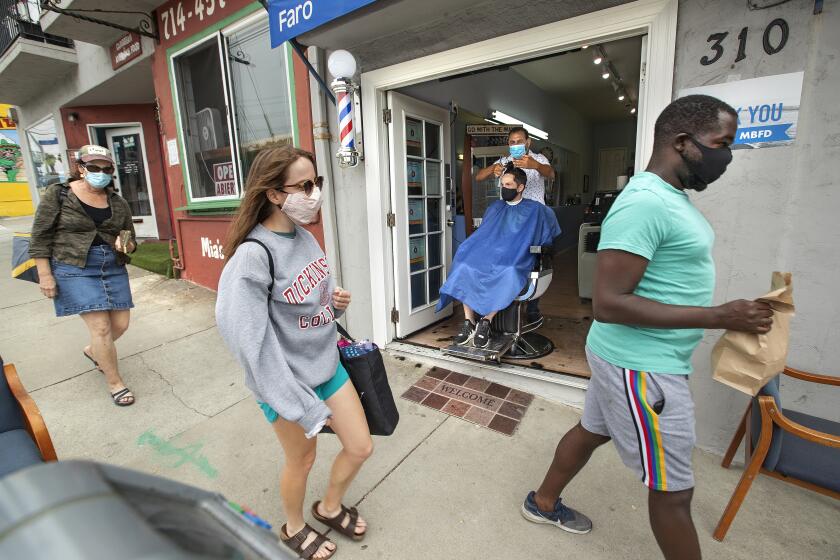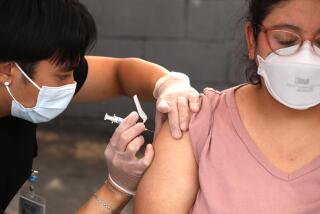Can the coronavirus live on clothes and shoes? And for how long?

- Share via
As Los Angeles County embarks on a slow reopening, there are more reasons to leave the house: Some stores are offering curbside pickup, hikers are headed back to some trails and beachgoers can dip their toes in the Pacific.
Going outside typically requires wearing clothes. So with the coronavirus still a very real threat, how worried do you have to be about the virus hitching a ride home on your shirt, pants or shoes?
How long does the virus live on clothing?
Experts believe the virus can live for up to 24 hours on clothing and similar surfaces. Exposure to a smaller concentration of the virus could reduce that time to just five minutes, according to a 2005 study on the virus that causes SARS, which has properties similar to those of the new coronavirus.
A study in the New England Journal of Medicine in March has been at the center of much of the discussion of how long the coronavirus can survive on different surfaces. Researchers found that the virus could live up to three days on stainless steel surfaces and plastic, and up to 24 hours on cardboard.
Clothing was not tested. But “you can pretty much think of a material like clothing to be somewhat more like cardboard material,” said Dr. Armand Dorian, chief medical officer at USC Verdugo Hills Hospital. Like cardboard, most clothing has absorbent fibers that appear to make the virus dry up more quickly than do hard surfaces.
Eugenia Khorosheva, a molecular biology instructor at Caltech, noted that the studies looked at known concentrations of the virus — something impossible to gauge when you’re out and about. So, for practical purposes, it’s better to assume the maximum of 24 hours.
Do I need to wash my clothes every time I come home?
Let’s start with the comforting news. For people who don’t work in high-risk settings or knowingly come into contact with the virus, experts agree that it’s not necessary to throw your clothes in the wash after returning from routine trips to the grocery store, pharmacy or a walk around the block.
As long as you don’t lean against things in the store, clothing should remain relatively uncontaminated, said Dorian, who is also an emergency room doctor. The virus is more likely to land on clothing from someone coughing or breathing out the virus, which is why keeping the recommended six-foot distance is important.
“The virus won’t jump off the clothing and infect anybody,” Dorian said. “The only way the virus can infect the next person is if the next person touches the clothing and then subsequently uses their hands to touch their eyes, nose or mouth.”
That’s why vigilant handwashing and avoiding touching your face with your hands is crucial, according to Dorian. He suggests imagining your hands are covered in paint to remind yourself not to adjust your mask or do some other seemingly innocuous activity. Dorian says he uses only one hand while shopping.
Those who work in hospital settings or other places where there is likely a high concentration of the virus are advised to change their clothes before returning home.
When returning from the hospital, Dorian changes clothes in his garage, then throws his dirty clothes directly into the wash. (The Centers for Disease Control and Prevention recommends laundering clothes using the warmest setting possible and drying them completely.)
The need to err on the side of caution increases if you are vulnerable to a serious case of COVID-19, according to Khorosheva.
“If you have someone in your household who has diabetes, who has high blood pressure, who is over, let’s say, 65 years old — come on, just remove the jacket and wash it,” she said.
Trying to get a handle on how California is reopening and what it means for you? Our guide includes updates and tips for remaining healthy and sane.
What about shoes?
Shoes, unlike clothes, will definitely come into contact with the ground, which Dorian says has long been recognized as an area of potential contamination.
Dorian always switches shoes before reentering his home after an outing. But he says it’s not crucial for those who don’t stomp around in areas where the virus is likely to be lurking.
“You don’t have to be anal about it if you’re not that worried,” he said. “Then you just have to consider the floor in your house a ‘dirty zone.’”
That means if you drop your keys on the kitchen floor, it’s good practice to sanitize your hands and the keys.
Wait, you said the virus lives on cardboard for 24 hours. What about all those packages on the porch?
If it’s possible, just leave the packages outside for a full day and the virus will probably die, Khorosheva said.
Pushing them into the sun could help, said Dorian, adding that heat breaks down the virus more quickly.
Boxes can also be sprayed with a solution of at least 70% ethanol, according to Khorosheva.
When she returns from the grocery store, she sprays most boxed items with an alcohol solution before transferring them to a clean bag and taking them inside. Many fruits and vegetables can be washed with soap and water or left in a cupboard for a few days to naturally decontaminate, she added.
Dorian opens boxes delivered to his door and then immediately disinfects his hands.

Anything else to worry about?
The virus lives longer on glass, plastic and some metals than clothing and cardboard. So when restaurants, movie theaters and other places open up, Dorian says it will be important to make sure surfaces like armrests and tabletops are disinfected each time they are touched.
“You should take it upon yourself to make sure you’ve cleaned it or you’ve seen somebody else clean it,” Dorian said.
Prioritize the highest risks
People who work in biosafety labs say that if there are too many rules, it’s impossible to follow them, Khoroseva said.
“So people should estimate the highest risk, and eliminate that,” Khoroseva said. “And after that, if they want to, they can start eliminating other risks as well.”
In other words, definitely wash your hands, wear a mask in public, social distance and avoid touching your face. Additional precautions will depend on your unique situation.
To contain the spread of COVID-19, parks, restaurants and stores are slowly reopening.









